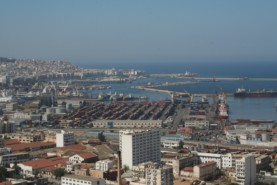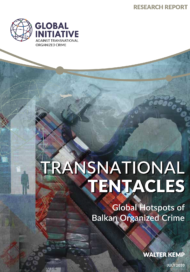Posted on 08 Jul 2022
In May 2022, Europol and the European Monitoring Centre for Drugs and Drug Addiction (EMCDDA) warned that the cocaine and methamphetamine markets in Europe were a growing threat. More needs to be done to address this criminal market at the European level.
According to the Global Initiative Against Transnational Organized Crime (GI-TOC)’s Global Organized Crime Index, Europe is the continent with the lowest overall criminality levels after Oceania – with a score of 4.48 out of 10 (10 being the highest score for criminality). According to the Index findings, the most pervasive criminal markets at a continent-wide level in Europe are human trafficking, human smuggling, arms trafficking, and flora and fauna crimes. However, there is considerable disparity between regions in Europe: zooming in on the 27 countries of the EU, the landscape changes completely.
The most pervasive criminal markets in EU countries are the synthetic-drug trade, the cocaine trade, human trafficking, the cannabis trade and human smuggling. For 21 out of the 27 EU countries, the cocaine trade has the third highest score across the 10 markets. 22 countries reported trafficking in synthetic drugs as having the third highest score.
This suggests that illicit drug markets are particularly relevant in the EU and that the concern of European authorities regarding cocaine and methamphetamine trafficking is indeed justifiable. If corrective action is not promptly taken by authorities, the EU will soon witness mounting health-related and violent incidents linked to the drugs trade.
An entrenched market
Two issues show the magnitude of the problem. First, Europe continues to be a major consumer market for cocaine. International organizations and national drug-monitoring agencies in EU countries suggest that there is increasing availability of cocaine in Europe and that purity at retail level has significantly grown, although prices remain stable.
Cocaine is the most widely used illegal stimulant drug in the EU. Although consumption levels vary from country to country, it is believed to be more pronounced in southern and western Europe. EMCDDA estimates suggest that 14 million people in the EU (aged 15–64) have used cocaine at some stage and, among those, 3.5 million have used cocaine over the last year. Since 2019, most countries reported either an increase or stabilization in the prevalence of cocaine use. This was also confirmed by data on the growing numbers of people accessing treatment for cocaine use and on the nearly 500 cocaine-related deaths in the EU in 2020.
The overall increase in cocaine use in Europe is also confirmed by wastewater analysis in 147 cities, indicating a pronounced spike after 2015. Additionally, although cocaine retailing is generally thought to be in person, data collected from novel methods found that sales are moving to social media platforms and encrypted communication tools, making drugs accessible to anyone with an internet connection.
The second issue has to do with cocaine trafficking. The second largest global corridor of cocaine (after the supply chain linking production markets to North America) originates in the Andean countries and is bound for European markets, in particular countries in the EU. In 2020, record quantities of cocaine (over 214 tonnes) were seized in Europe. Of all these seizures, 70 per cent occurred in just three countries: Belgium, the Netherlands and Spain. Despite efforts to seize larger quantities of the drug, the fact that prices remain stable and cocaine purity is increasing would indicate that more cocaine is evading seizure and reaching the EU markets.
The all-powerful cocaine cartel monopolies of the past have atomized into a multitude of potential suppliers operating across several countries, counting on prominent ‘narcobrokers’ with territorial influence and transport infrastructures, so it is likely that heightened competition will translate into increasing levels of violence among suppliers, as is already occurring in some countries. For example, in Spain, across the crime-ridden Costa del Sol, fatal score-settling incidents have been linked to transnational criminal networks competing violently for drug territory and merchandise.
A comprehensive response
The Index’s results indicate that levels of corruption within EU states are low to moderate, with countries having sufficient capacity and will to address the challenges of organized crime in the region. Under the Index, EU countries score higher on resilience (6.58) than Europe as a whole (6.23). But how long will the EU authorities be able to counter the pressure from the mounting global cocaine trade?
The EU’s existing counternarcotic responses will not be able to confront this trade unless the scale of the problem is acknowledged by national and regional authorities, and policies aimed at counteracting the cocaine trade and its use are implemented promptly. Policymakers need to recognize that transnational organized crime, and in particular the cocaine trade, is a complex phenomenon that cannot be simplified to the mere transposition of EU directives into national legislation, which often becomes an inconsistent patchwork of laws.
In addition, stakeholders need to acknowledge that the cocaine trade and consumption affect the whole of the EU, and not only those countries where the problem is manifested more openly and violently. The cocaine market generates hefty amounts of money – profits that can readily buy protection and be stealthily laundered, blending imperceptibly into the legal economy. Preventive controls are therefore needed, and vulnerable population groups need to be supported, as they contribute human and operational resources to the trade.
The EU has achieved a solid raft of enforcement policy against organized crime in terms of policing, prosecution, judicial and penitentiary resources. But much remains to be done in the economic, social and welfare spheres to achieve a true culture of lawfulness that can serve as a sustainable, resilient barrier to organized crime in the long term.
This analysis is part of the GI-TOC’s series of articles delving into the results of the Global Organized Crime Index 2021. The series explores the Index’s findings and their effects on policymaking, anti-organized crime measures and analyses from a thematic or regional perspective.
Subscribe to the dedicated newsletter to get regular updates about the project.



